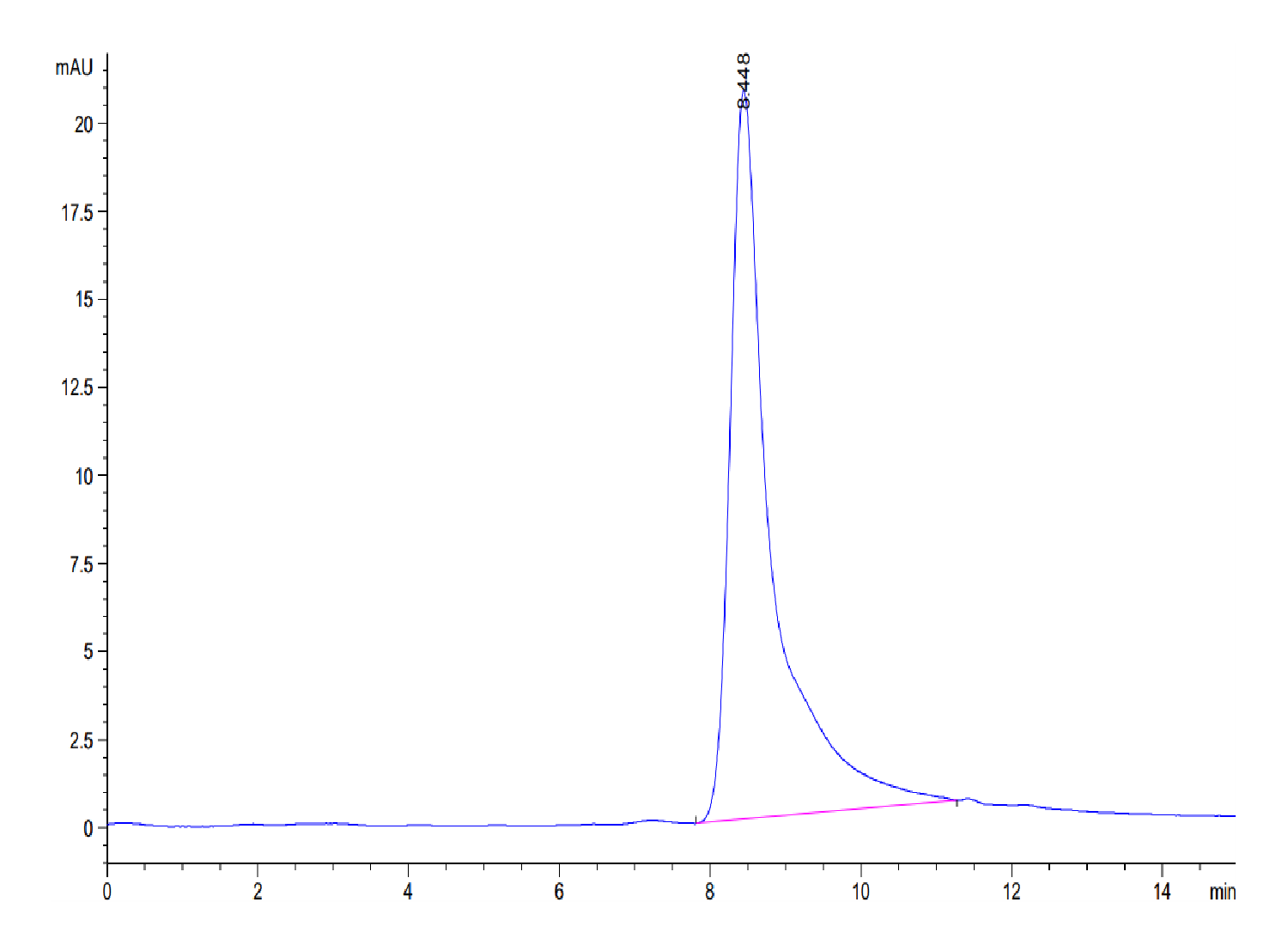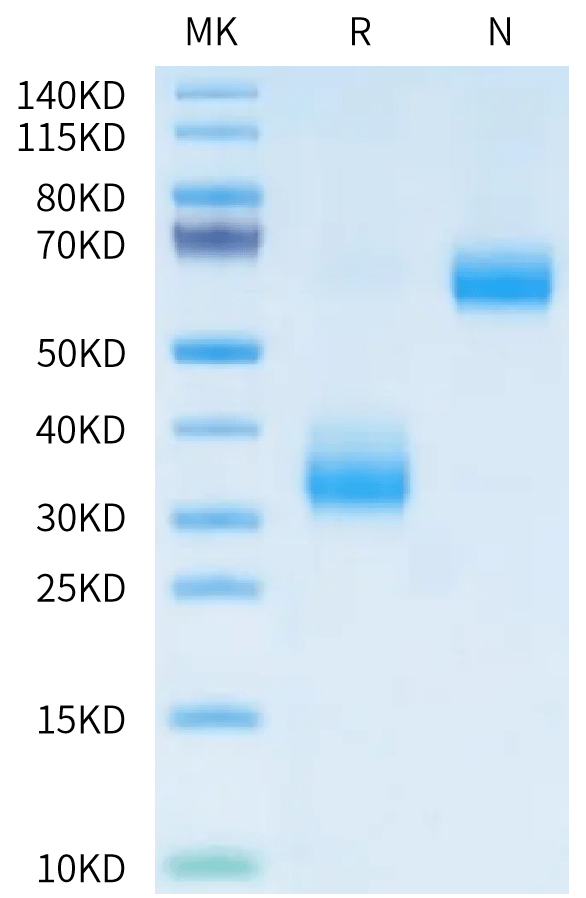| Weight | 1 lbs |
|---|---|
| Dimensions | 9 × 5 × 2 in |
| accession | P78380 |
| express system | HEK293 |
| product tag | N-His |
| purity | > 95% as determined by Tris-Bis PAGE;> 95% as determined by HPLC |
| background | LOX-1 is a transmembrane glycoprotein that binds to and internalizes ox-LDL.LOX-1 gene deletion in mice and anti-LOX-1 therapy has been shown to decrease inflammation, oxidative stress and atherosclerosis. LOX-1 deletion also results in damage from ischemia, making LOX-1 a promising target of therapy for atherosclerosis and related disorders. In this article we focus on the different mechanisms for regulation, signaling and the various effects of LOX-1 in contributing to atherosclerosis. |
| molecular weight | The protein has a predicted MW of 25.4 kDa. Due to glycosylation, the protein migrates to 30-36 kDa under reduced condition and 60-70 kDa under Non reducing (N) condition based on Tris-Bis PAGE result. |
| available size | 100 µg, 500 µg |
| endotoxin | Less than 1EU per μg by the LAL method. |
Human LOX1 Protein 3747
$270.00 – $900.00
Summary
- Expression: HEK293
- Pure: Yes (HPLC)
- Amino Acid Range: Ser61-Gln273
Human LOX1 Protein 3747
| protein |
|---|
| Size and concentration 100, 500µg and lyophilized |
| Form Lyophilized |
| Storage Instructions Valid for 12 months from date of receipt when stored at -80°C. Recommend to aliquot the protein into smaller quantities for optimal storage. Please minimize freeze-thaw cycles. |
| Storage buffer Shipped at ambient temperature. |
| Purity > 95% as determined by Tris-Bis PAGE |
| target relevance |
|---|
| LOX-1 is a transmembrane glycoprotein that binds to and internalizes ox-LDL.LOX-1 gene deletion in mice and anti-LOX-1 therapy has been shown to decrease inflammation, oxidative stress and atherosclerosis. LOX-1 deletion also results in damage from ischemia, making LOX-1 a promising target of therapy for atherosclerosis and related disorders. In this article we focus on the different mechanisms for regulation, signaling and the various effects of LOX-1 in contributing to atherosclerosis. |
| Protein names Oxidized low-density lipoprotein receptor 1 (Ox-LDL receptor 1) (C-type lectin domain family 8 member A) (Lectin-like oxidized LDL receptor 1) (LOX-1) (Lectin-like oxLDL receptor 1) (hLOX-1) (Lectin-type oxidized LDL receptor 1) [Cleaved into: Oxidized low-density lipoprotein receptor 1, soluble form] |
| Gene names OLR1,OLR1 CLEC8A LOX1 |
| Mass 9606Da |
| Function Receptor that mediates the recognition, internalization and degradation of oxidatively modified low density lipoprotein (oxLDL) by vascular endothelial cells. OxLDL is a marker of atherosclerosis that induces vascular endothelial cell activation and dysfunction, resulting in pro-inflammatory responses, pro-oxidative conditions and apoptosis. Its association with oxLDL induces the activation of NF-kappa-B through an increased production of intracellular reactive oxygen and a variety of pro-atherogenic cellular responses including a reduction of nitric oxide (NO) release, monocyte adhesion and apoptosis. In addition to binding oxLDL, it acts as a receptor for the HSP70 protein involved in antigen cross-presentation to naive T-cells in dendritic cells, thereby participating in cell-mediated antigen cross-presentation. Also involved in inflammatory process, by acting as a leukocyte-adhesion molecule at the vascular interface in endotoxin-induced inflammation. Also acts as a receptor for advanced glycation end (AGE) products, activated platelets, monocytes, apoptotic cells and both Gram-negative and Gram-positive bacteria.; (Microbial infection) May serve as a receptor for adhesin A variant 3 (nadA) of N.meningitidis. |
| Catalytic activity #N/A |
| Subellular location Cell membrane; Lipid-anchor. Cell membrane; Single-pass type II membrane protein. Membrane raft. Secreted. Note=A secreted form also exists. Localization to membrane rafts requires palmitoylation. |
| Tissues Expressed at high level in endothelial cells and vascular-rich organs such as placenta, lung, liver and brain, aortic intima, bone marrow, spinal cord and substantia nigra. Also expressed at the surface of dendritic cells. Widely expressed at intermediate and low level. |
| Structure Homodimer; disulfide-linked. May form a hexamer composed of 3 homodimers. Interacts with HSP70.; (Microbial infection) Binds to the head and beginning of the coiled stalk of N.meningitidis adhesin A (nadA) variant 3; binding can be abrogated by monoclonal antibodies against the specific regions of NadA. Binding occurs in protein microarrays, in solution and when LOX-1 is expressed on the cell surface. |
| Post-translational modification The intrachain disulfide-bonds prevent N-glycosylation at some sites.; N-glycosylated. |
| Domain Th |
| Target Relevance information above includes information from UniProt accession: P78380 |
| The UniProt Consortium |
Data
 |
| The purity of Human LOX1 is greater than 95% as determined by SEC-HPLC. |
 |
| Human LOX1 on Tris-Bis PAGE under reduced condition and Non reducing (N) condition. The purity is greater than 95%. |
Publications
Publications
| pmid | title | authors | citation |
|---|---|---|---|
| We haven't added any publications to our database yet. | |||
Protocols
| relevant to this product |
|---|
Documents
| # | ||
|---|---|---|
| Please enter your product and batch number here to retrieve product datasheet, SDS, and QC information. | ||














